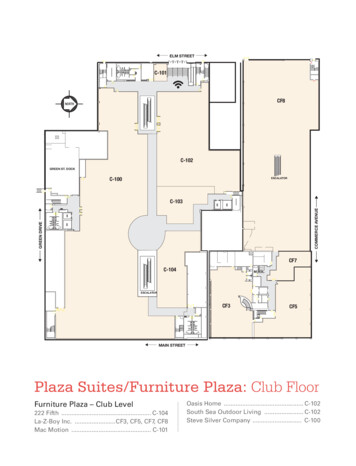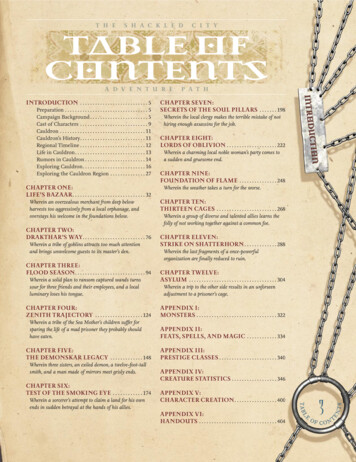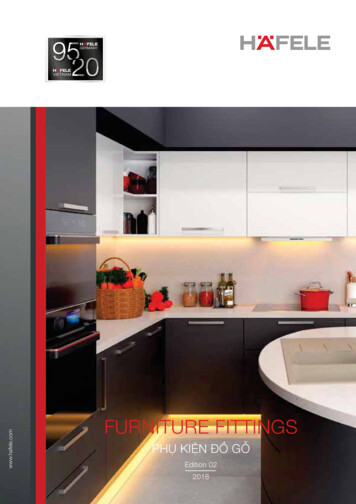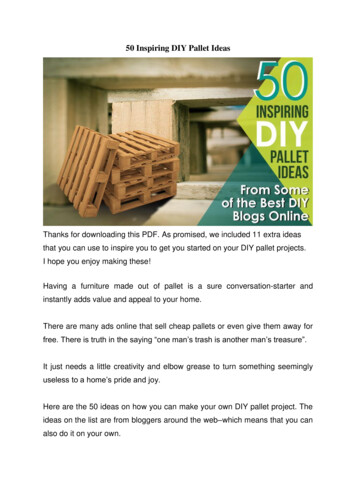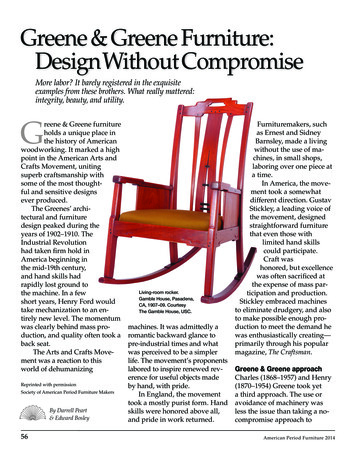
Transcription
Campaign Furniture
CampaignFurnitureby Christopher Schwarz
Published by Lost Art Press LLC in 201426 Greenbriar Ave., Fort Mitchell, KY 41017, USAWeb: http://lostartpress.comTitle: Campaign FurnitureAuthor: Christopher SchwarzEditor: Megan FitzpatrickAcquisition Editor: John HoffmanIndex: Suzanne EllisonCopyright 2014 by Christopher SchwarzISBN: 978-0-9850777-9-2First printing.ALL RIGHTS RESERVEDNo part of this book may be reproduced in any form or by anyelectronic or mechanical means including information storage andretrieval systems without permission in writing from the publisher,except by a reviewer, who may quote brief passages in a review.This book was printed and bound in the United States of America.
ContentsPreface vii1. Campaign Style2. Campaign Woods3. Campaign Hardware4. Campaign Chests5. Campaign Secretaries6. Folding Camp Stool7. Roorkee Chairs8. Strong Trunk9. Field Desk10. Collapsible Bookshelves11. Traveling BookcaseAfterword. 265AppendicesA. Roubo on Campaigning. 269B. India’s Joiners, by George Cecil. 279C. Army & Navy Stores. 285Acknowledgements 318Further Reading 319Index 323Hardware Sources 3311385282122138154190214234248
fig. 1. “Sgt. J. Craig,” an oil on canvas by an unknown artist, circa 1870.(Courtesy of the Council of the National Army Museum, London)
PrefaceRugged &SimpleLike a dormant case of malaria, my fevered love for campaign furniture beganmany years ago without my knowledge – probably during some hot Connecticut summer.My maternal grandparents’ home (and ours) was full of campaign furniture.When you drank tea with grandmother West, it was on a folding coaching tablemy grandfather had built. My grandfather, an enthusiastic woodworker, hadbrought back campaign brasses from his trips to Asia, some of which I still own. Sohis pieces definitely had an Anglo-Indian campaign feel to them. And when youvisited the West’s house for the summer, you put your clothes in a campaign chest.My father and mother were fond of the furniture as well. And when my dadbuilt pieces for our home they were at times festooned with brass corner guards,brackets and flush-mount pulls.As a child, I didn’t think much of the provenance of all this furniture. In fact, Iassumed it was Chinese or Japanese furniture because my grandparent’s house wasalso awash in tansu, Chinese chests and ink paintings of landscapes and animals.Eventually I wised up and sorted out the furniture record of all our households. The campaign style became a favorite of mine, and I wanted to build piecesof it for the magazine I worked for at the time, Popular Woodworking.
viii campaign furnitureMy fellow editors, however, were inoculated against the bug. There was almostnothing written about the style of furniture. And whenever we surveyed our readership, subscribers told us that there were three furniture styles they preferred:country (anything with a duck or pineapple on it), Shaker and Arts & Crafts.“Campaign furniture” was somewhere down the list near “narwhal nose guards”in popularity.I persisted. I was rejected again. And after I stepped down as editor in 2011, Iasked them one last time to publish two articles – one on campaign chests and asecond on Roorkee chairs. After some wrangling and veiled threats, they said OK.That was the start of my obsession with researching and building campaignfurniture. Since 2010, I have been neck-deep in researching the style of furniturethat I cannot remember living without. During the last 200 years, there has beensurprisingly little written about campaign furniture, which also goes by the nameof “barracks furniture,” “camp furniture” or sometimes “patent furniture.” There’san excellent book by Nicholas A. Brawer that is the single reference work for collectors and dealers, but it is out of print. Plus there are some magazine articles.Most of the knowledge out there on campaign furniture is in the hands ofauctioneers, antique dealers and restorers. So my research began with their salesrecords, and that led me to the catalogs of the British furniture makers of the 19thand early 20th centuries. Plus I dug up several helpful 19th-century books thatsought to prepare a British citizen for a long trip abroad.The real surprise from my initial research was that these pieces of beautiful“military” furniture weren’t just for the military. With the incredible expansion ofthe British Empire in the 19th century, there was an urgent need for a bureaucracyto manage the Empire’s colonies. (Brawer writes in his book that by 1897 the British Empire comprised one-quarter of the world’s land surface.)So these campaign chests, folding tables, collapsible chairs and writing deskswere in use by bureaucrats, writers, doctors, merchants – plus their families – allover the globe.Even more interesting: The knockdown aspect of the furniture made it popular with city dwellers who were crammed into tiny city flats – it allowed them toconvert a parlor to a dining room to a bedroom. And if you left England on aship to colonize an island, such as New Zealand, this type of furniture filled yourstateroom during the journey and your home when you arrived.Oh, and if you were a student who left home to go to school, you might totealong some of these items, such as a folding bookcase and a writing slope.In fact, the romantic idea that all of these pieces of campaign furniturewere portaged on the backs of elephants through the jungle is mostly off themark. In truth, most of these pieces of furniture were the workaday backbone of furniture for people who needed stuff that that was rugged, simpleand a bit stylish.
preface ixAnd that idea – rugged, simple and stylish furniture – is what kept mecoming back to the belief that campaign furniture is a sorely underappreciated furniture form.As a woodworker, I love the first-class joinery: dovetails plus mortise-andtenon joints. The simple and rectilinear lines are easy for beginners to make andare as familiar as Shaker or Arts & Crafts items. If you’re not a woodworker, I hopeyou can appreciate the simple forms and clean lines that look good in almost anyroom, whether you fill your rooms with 18th-century stuff or Bauhaus. Campaignfurniture fits in everywhere, across the globe and in every time period.I think that’s true in part because it was truly an international furniture style.The roots of the style might indeed be related to tansu, as some have suggested,or in Chinese traveling forms, as others contend. But what is certain is that whenAsian craftsmen saw these British forms they reinterpreted them for their customers. When their customers took these pieces back to England, the cabinetmakersthere were influenced by the changes made by their far-flung brothers. And soforth and so on.When I finally made that last connection to that circle, I didn’t feel so stupidabout assuming that my grandparents’ campaign furniture was from Asia.It is my hope that this book opens your eyes to a style of furniture that wasaround for about 200 years – 1740 to World War II by some reckonings – andremains sturdy and stylish (if somewhat underappreciated) today.This book is not an academic investigation of this furniture style – I will leavethat desperately needed task to more capable researchers. Instead, this book is atoo-short look at the furniture style from a builder’s perspective. My interest is inthe wood, the hardware, the joinery and the different forms themselves.I think that if you put your hand to building these pieces to the high standards of the 18th and 19th centuries, you will become fascinated – might I say“infected” – by their cleverness and soundness of construction.Campaign furniture was meant to endure a mobile existence and do it with abit of grace. To be sure, we are a more mobile society now than we were 200 yearsago and sorely need furniture that is easy to move. And if you have bought anyfurniture in the last 50 years, you also know that most factory furniture is doomedto self-destruct within a few years.We need campaign furniture more than ever before. Fill your house with it,and the ideals it embodies – sturdiness, simplicity and beauty – might just seepinto the unconscious minds of your children or grandchildren as it did for me.Christopher SchwarzFort Mitchell, KentuckyJanuary 2014
fig. 6.1. A camp stool in teak with latigobridle leather and copper rivets.
Chapter 6FoldingCamp StoolThree-legged folding stools appear in many Western cultures, includingthe French, English and American. They have been popular with soldiers,sportsmen, campers and artists for at least two centuries.This stool is a great introductory project to campaign furniture, especiallyif you are new to turning or working with leather. There are only three piecesof wood, four pieces of leather and some metal hardware. You can easilybuild one in a day.Choosing MaterialsI have seen some of these camp stools built using dowels, and they are strongenough to hold most people. However, I like to build them from mahogany, teakor ash that has dead-straight grain. I’ve had nightmares about getting a stick stuckin my backside from a stool disaster.If you can build the stool with riven stock (oak or ash are good choices), it willbe quite strong. Many original stools used 1"-diameter legs. However, my recommendation is to use stouter stock. I have built reproductions with 1"-diameterlegs, and they felt too springy under my 185-pound frame.You don’t need to make the legs baseball bats, but try for something between
140 campaign furnitureFig. 6.2 Have a seat. While some of these stools show up with four legs, the threelegged ones are easier to build and are better on rough terrain. This is a drawing ofan ash version from the 19th century with a stitched leather seat.
folding camp stool 1411-1/8" diameter to 1-1/4" diameter. The leather can be almost anything 7 ounces(just shy of 1/8" thick) or heavier. Vegetable-tanned leather that you dye yourselfis a particularly strong choice.You also will need rivets to join the leather pieces – unless you are skilled athand-stitching. While hollow rivets (sometimes called rapid rivets) are inexpensive, easy to find and strong enough, I prefer the look and unerring permanence ofsolid copper rivets. I used No. 9 rivets with posts that are 1/2" long.To attach the leather to the wooden legs, you’ll need three No. 10 x 1-1/2"long brass screws plus matching finishing washers.Finally, you’ll need the hardware that allows the legs to open and shut. Traditionally, this was a three-headed bolt that once was easy to find. Now, that hardware is rare in North America. If you are a blacksmith or have access to a goodwelder, making a three-way bolt is straightforward. I have seen a couple of thesebolts for sale in England, but the price with shipping to the United States wasmore than the cost of the bolt itself.So I looked for a different way. Luckily, the Internet is good for somethingother than photos of cats playing keyboards. One maker of custom stools usessome off-the rack hardware to make an effective three-way bolt and shares thatinformation freely on his web site.Here’s what you need for legs that are up to 1-1/4" in diameter: A hex-headed bolt with a 5/16" shank that is long enough to pass throughtwo of the legs and protrude out the other side by 1/2". A 3"-long hexhead bolt will work with 1-3/16"-diameter legs.An eyebolt with a 1/4" or 5/16" shank that is long enough to pass throughone of the legs and protrude out the other side by 1/4". (Note: You canhacksaw any of this threaded hardware to length. An eyebolt that has atotal length of 2-1/2" should be sufficient.)Two acorn-headed nuts.Three washers.15 No. 9 copper rivets.Turn the LegsThe three legs are easy to turn, even if your favorite turning tool is #80-grit sandpaper. Turn the legs to round using a roughing gouge or carbide-tipped roughingtool. Create a smooth, clean cylinder of about 1-1/4" in diameter with a skew orother finishing tool.The feet shown are 1-3/16" in diameter and 5/8" tall. Make the feet by turning down the foot. Then turn the ankle to 7/8" in diameter. Round the foot,then taper the rest of the leg down to the ankle. The taper should begin 6" fromthe bottom of the leg.
142 campaign furniture Folding Camp Stool No. part sizes (inches)TWL3Legs1-1/4 dia.23-3/41Seat7 oz.13-1/213-1/23Lips7 oz.38
folding camp stool 1431-1/4"11-5/8"23-3/4"3/4"6"3/4"Leg Elevation
144 campaign furniture13-1/2"1-1/2" r.Seat PlanScale:1"Lips PlanI added four small grooves where the hardware holes will go – two above thehardware and two below. Little details such as these grooves and beads make thelegs look like something fancier than three store-bought dowels.Sand the legs to remove any rough tool marks. I finished the legs on the lathe.First I burnished the surface with a “polissoir” (a French polishing tool made fromtightly bound broom corn). Then I applied beeswax to the legs with the workpiecespinning. I used the polissoir to drive the beeswax into the pores of the wood(again, while the lathe was spinning). Then I used a rough cotton cloth (I’d like to
folding camp stool 145Fig. 6.3 A bulbous foot. The foot can be almost any shape, from a bead similar tothe foot of the Roorkee to this teardrop.Fig. 6.4 Not original. These little grooves add some visual interest to the joint.However, they’re not a detail I found on any original stool. So skip them if you aregoing for authenticity.
146 campaign furnitureFigs. 6.5 & 6.6 Dead center. The holesfor the hardware need to be boredthrough the middle so the leg isn’tweak. A cradle helps hold the legs fordrilling, no matter how you make thehole. Drill the hole so the brad pointof the bit barely pokes through the leg(right). Rotate the leg so the tiny holeleft from the brad point is facing up.Finish the hole.be fancy and say it was muslin, but it was an old bag that held corn grits) to buffthe wax. Then I applied another coat of wax and buffed that.If you want to add a little age to the wood, apply a coat of black wax and pushit into the grooves and pores. Let the wax set up then buff it.Wax is not a permanent finish, but it is easily renewed or repaired if your stoolis for the drawing room instead of the campsite.
folding camp stool Figs. 6.7 & 6.8 Common hardware. The bolt, eyebolt, washers and nuts are allitems found easily at a half-decent hardware store.147
148 campaign furnitureBore Three HolesAll three holes are located in the same spot on each of the three legs and should bethe same diameter – just big enough to allow the hardware to pass through. Theholes are located 11-5/8" down from the top of the legs.The best way to bore these holes is with a drill press or hand-powered postdrill. You want the hole to be dead straight and pass through the middle of the leg.If you are a whiz with a hand drill or cordless drill then go for it.Install the HardwareStrip the hardware of its zinc if you like – I use a citric acid solution for this. Here’show the hardware goes together: Put a washer on the bolt. Push the bolt through one leg.Place the eyebolt on the post of the bolt. Put the other leg on the bolt.Add a washer to the end of the bolt, then drive on the acorn nut.Push the post of the eyebolt through the third leg. Add a washer andacorn nut.Drill pilot holes that are deep enough to receive the No. 10 screws into thetop ends of the legs.Leather SeatThe seat is four pieces of material: a triangular seat and three pockets that look abit like lips when you cut them out. When I cut out leather, I make patterns formy pieces from thin MDF or hardboard – usually 1/4"-thick material.Put the patterns on the leather and cut out the seat and three lips usinga sharp utility knife.You can hand-stitch the lips to the seat. If you aren’t up for stitching, rivetswork well and give the project a military flair.Secure each lip to the seat first with one rivet at one of the tips of the seat.Punch a snug hole for the rivet through both pieces of leather, drive on the washeror “burr,” snip off the excess and peen the post over the burr.Now bend one end of the lip up and rivet the end to the seat about 1/4"from the end of the lip. Repeat for the other end of the lip. Finally, add twomore rivets between the three existing rivets. Repeat the whole process forthe other two corners.One quick note on neatness: Be sure to put the burr so it faces the floorfor all these joints.After the pockets are riveted, use a sharp utility knife to trim any little bits ofthe pocket that aren’t flush to the seat.If you purchased undyed leather, finish the leather with a dye, oil and
folding camp stool 149Fig. 6.9 Knife work. You will probablymake more than one stool, so make plywood patterns of the seat parts and cutthem out using a sharp utility knife.Fig. 6.10 First punch. Using a leatherpunch, make a hole through the seatand pocket piece. I’m using a kitchencutting board as a backer.Fig. 6.11 Insert the rivet. Put the rivetthrough the holes. The flat face of therivet should be on the top surface of theseat.Fig. 6.12 Like a washer. The “burr” partof a traditional rivet is what pinchesthe leather. Place it over the post. Thendrive it on the post with a rivet setter.
150 campaign furnitureFig. 6.13 Snip it. The post of the rivetshould extend about 1/16" or so fromthe burr. I use nail pincers to snip thepost to length.Fig. 6.14 Peened. Some people peenthe rivet freehand with a hammer. I usea rivet setter, which makes a tidy dome.It’s personal preference.Fig. 6.15 Five rivets. Each pocket is secured with five rivets. One at the peak of thecurve. Rivet the ends of the lips, then fill in with the rivets between.
folding camp stool 151When Reproductions FailWhen I build a reproduction, I am loathe to make a significant change to itsdesign until I’ve built one as close to the original as possible.It’s easy for the modern mind to feel superior to a dead brain. And often wemake changes that are unnecessary or reduce the functionality of the original.When I built my first campaign stool, I stuck to an original pattern that used1"-diameter legs. They looked spindly, but I didn’t condemn them until I hadsat on an exact repro. So I turned up six 1"-diameter legs for two mahoganystools. The grain was dead-straight.I assembled the first stool, put it on the shop floor and sat down as gently asI could. As soon as my weight shifted from my feet to my butt I heard a snap. Istood up with visions of a trip to the emergency room for a stick-ectomy.One of the three legs had snapped where the hardware penetrated the leg.Despite this failure, I assembled the second stool with the remaining 1"-diameter legs and tested it. Those legs held together fine, which led me to thinkthat perhaps the one broken leg was a piece of brash wood.But I didn’t like the feel of the stool with 1"-diameter legs. It was too springy.So I went back to the lathe and turned legs of varying diameters, from a shademore than 1" to 1-1/4". After assembling these stools and asking people to siton them, I found that 1-1/4" was the diameter I liked best. I’m 185 pounds, andpeople heavier than me (up to 250 pounds) felt comfortable on the stool.If you don’t believe me, the good news is that this stool uses little wood andcan be knocked out quickly. Give it a try yourself. But if you opt for skinny legs,make sure your health insurance is paid up.
152 campaign furnitureFig. 6.16 Finishing washers. The brass washer gives the screw head some extrabite into the leather – and it looks nice, too.wax. Burnish the edges with a piece of wood and a little spit (water will donicely as well).Attach the seat to the legs. Punch a clearance hole through each lip that willallow a No. 10 screw to pass. Screw the leather to the legs with a finishing washerunder the head of each screw.That’s all there is to it. You can make the stool easy to transport by making abelt that will go around the girth of the closed stool and screwing that belt to oneleg. Or you could make a canvas bag embroidered with your football team’s logo.After all, when going into battle, it’s always best to fly your colors.
folding camp stool 153Make a 3-way BoltAs I was finishing work on this book, woodworker Mike Siemsen sent me aclever three-way bolt he had made from off-the-rack hardware. Accordingto Siemsen, here’s how to make it. Hardware needed: A 1/2"-13 heavy hex nut. (Regular nuts will not work well; get low carbon, not hardened.)Three 5/16"-18 x 2-1/4" bolts (machine screws, get low carbon, nothardened.)One 5/16"-18 nut (for cutting off the bolts to length).Three 5/16" washers.You will also need a 5/16"-18 tap, a drill for the pilot hole (F-size bit which is.257"; 1/4" will probably work) and a drill press.Center punch the center of every other face on the 1/2" heavy hex nut, put itin a drill press vise and bore the pilot holes for the tap. You can then either runthe tap by hand or put the tap in the drill press and turn it by hand, no power!Keep things square to the face being drilled.Next take the three 5/16" bolts, screw the nut on them all the way up to theunthreaded portion and saw off the excess end. Remove the nut and file orgrind the burr off. It is important that the unthreaded portion be around 1-1/4"long.You can blacken the hardware, or remove the hardware’s zinc coating usinga citric acid solution and let it patinate naturally. The hole in the 1/2" nut is anice place to add a wooden cap or a small turned finial.
Campaign furniture was meant to endure a mobile existence and do it with a bit of grace. To be sure, we are a more mobile society now than we were 200 years ago and sorely need furniture that is easy to move. And if you have bought any furniture in the last 50 years, you also kn

